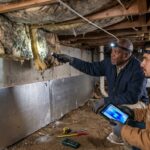Essential Guide to Foundation Repair: Ensuring Stability and Longevity for Your Home
When it comes to homeownership, there are few things more important than ensuring the stability of your foundation. After all, without a solid base, that lovely kitchen you adore or your cozy living room could eventually be at risk. So, let’s dive into the essential guide to foundation repair, exploring why it’s vital, how to detect issues, and the solutions that can keep your home standing tall for years to come.
Understanding Your Foundation
Before we plunge into the world of repairs, it’s crucial to understand what a foundation is and the role it plays in your home. Think of your foundation as the unsung hero of your house. Beneath your floors and walls, it ensures everything stays put while withstanding the test of time. Foundations come in various forms, ranging from concrete slabs to crawlspaces and basements. Each type has unique characteristics and potential vulnerabilities.
Why Foundation Issues Happen
Foundation problems can arise for a myriad of reasons. Some common culprits include:
1. **Soil Settlement**: The ground beneath your home can shift due to moisture changes, leading to settling, which can cause cracks and uneven floors.
2. **Poor Drainage**: Water is both a friend and a foe to your foundation. Improper grading, clogged gutters, and downspouts that empty too close to the house can lead to water pooling around the foundation.
3. **Tree Roots**: If your property is graced by large trees, their roots can disrupt the soil structure and even damage the foundation directly.
4. **Construction Errors**: Sometimes, the builders simply didn’t get it right. Insufficient footing depth, inadequate drainage solutions, and using low-quality materials can lead to problems down the line.
5. **Extreme Weather**: From droughts to heavy rains and sudden freezes, extreme weather can wreak havoc on the integrity of your foundation.
Signs of Foundation Problems
Now that you know why foundation problems happen, how do you identify them? Here are some red flags to watch out for:
– **Cracks in Walls or Floors**: If you start seeing cracks that resemble a game of Connect Four, it might be time to investigate further.
– **Uneven or Bouncy Floors**: Do your floors feel like they’re auditioning for a trampoline Olympics? This could indicate issues with your foundation.
– **Doors and Windows That Stick**: If your doors and windows have transformed into stubborn relatives who refuse to budge, it might indicate a problem with the foundation.
– **Gaps Between Walls and Ceilings**: These gaps can signal that your home is settling or shifting in an improper way.
– **Basement or Crawl Space Issues**: If you notice water pooling or dampness in these areas, it’s a signal that your foundation may require attention.
Conducting a Professional Inspection
If you’ve noticed any signs of foundation trouble, it’s wise to seek professional help. A qualified contractor can conduct a thorough inspection and provide a detailed assessment of your foundation’s health. During this time, they will examine the interior and exterior of your home, check for discrepancies, and may even use specialized tools to assess the foundation’s integrity accurately.
It’s worth noting that while DIY inspections can yield some insights, they may not capture every underlying issue. After all, unless you possess X-ray vision, it could be tricky to see beyond the surface.
Types of Foundation Repairs
Once the professionals have identified the issues, they’ll recommend the best course of action. Here are some common methods of foundation repair:
1. **Piering**: This technique involves installing steel piers deep into the soil to stabilize your foundation. The piers bear the weight of your home, preventing further settling. It’s like giving your house a set of superhero muscles!
2. **Slab Jacking**: For homes with concrete slab foundations that have sunk, slab jacking involves injecting a mixture beneath the slab to lift it back to its original position. Think of it as foundation therapy—lifting your home to new heights!
3. **Wall Anchors**: If your basement walls are bowing inward, wall anchors can help. These are installed outside the foundation and attached through the wall to stabilize and straighten it, much like giving your walls a supportive hug.
4. **Drainage Solutions**: If water is the root of your problems, improving drainage is critical. This could involve installing French drains, gutters, or landscape grading to direct water away from the foundation.
5. **Crack Repair and Waterproofing**: If vertical cracks are minor, they can often be filled with epoxies or other sealants. Additionally, applying waterproof coatings can prevent moisture from seeping in through those cracks.
Choosing the Right Foundation Repair Company
When it comes to hiring a foundation repair company, due diligence is your best friend. Here are some factors to consider:
– **Experience and Reputation**: Look for contractors with a proven track record. Reading reviews and getting references from previous customers can provide invaluable insights.
– **Free Estimates**: Reputable companies often provide free estimates, allowing you to compare pricing and services before committing.
– **Warranty Options**: Many companies offer warranties on their work. Ensure you understand what is covered and for how long.
– **Certified Professionals**: Check if the contractors are licensed and insured. Certification from reputable organizations can also be a good sign of their expertise and adherence to industry standards.
– **Clear Communication**: You want a team that communicates clearly about what needs to be done, how long it will take, and what the costs will be. Transparent communication is key to a successful partnership.
Preventing Future Foundation Problems
Once you’ve tackled any existing foundation concerns, it’s essential to adopt preventative measures to minimize future risks. Here are some tips to keep your foundation healthy:
– **Maintain Proper Drainage**: Regularly clean gutters and ensure downspouts direct water at least six feet away from your foundation.
– **Landscape Wisely**: Be mindful of your landscaping. Avoid planting large trees too close to your home, and ensure that flower beds don’t create excessive moisture around your foundation.
– **Monitor Soil Moisture**: If you live in an area prone to heavy rains or droughts, consider installing a moisture meter to keep an eye on the soil conditions around your home.
– **Regular Inspections**: Annual home inspections can catch issues early before they escalate into major problems.
– **Address Plumbing Issues Promptly**: Leaky pipes can contribute to soil saturation around your foundation, so tackling plumbing problems quickly is vital.
Conclusion
Your home’s foundation is paramount to its overall stability and longevity. By understanding the causes, recognizing the signs of issues, and taking action promptly, you can protect your investment and maintain a safe living environment. Remember to engage the help of seasoned professionals when necessary and implement preventative measures to keep your home standing tall.
With this essential guide to foundation repair, you’re now armed with the knowledge to tackle any challenges that may arise. While it may not be the most glamorous topic on the home improvement checklist, addressing foundation issues head-on is a surefire way to ensure your home remains a solid haven for years to come. So, let’s roll up our sleeves and get to work!


